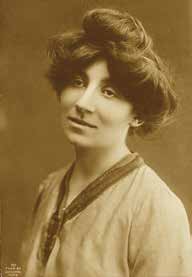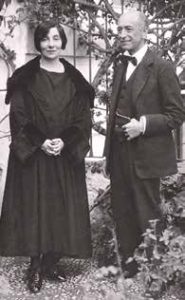The beautiful music filling the concert hall may have been familiar to some in the audience, but the sound of it was something unusual, unknown. In 1923, when Wanda Landowska played Handel’s Concerto for Harpsichord and Orchestra in B Flat in New York, it probably was the first time listeners had heard the instrument played in public. Her triumph was complete. More or less single-handedly, after an absence of almost 100 years, she had returned the harpsichord to performance for modern ears.
For decades, harpsichords had been considered relics of the past. To those used to the lush, emotional romanticism of 19th century performance practice, they sounded harsh, dry and monotonous. Landowska disagreed. The only way to perform the works of the great Baroque masters like Bach, Scarlatti, Couperin, and others—whose music was then mostly ignored or forgotten—was for her on the instruments for which they wrote it. Anything else, she believed, was dishonest, inauthentic and corrupt. Eventually, many concurred.
 Born on July 5, 1879, in Warsaw, Poland, Landowska was a child prodigy who became a dedicated musical scholar as well as a fine musician. Her goal was authentic performances with accurate scores of early music played on original instruments. She commissioned the construction of new harpsichords and returned long-forgotten works to the repertoire. Dedicated not only to the letter of the text, but also to its spirit, some of her recordings are now considered to be among the greatest in the history of preserved sound.
Born on July 5, 1879, in Warsaw, Poland, Landowska was a child prodigy who became a dedicated musical scholar as well as a fine musician. Her goal was authentic performances with accurate scores of early music played on original instruments. She commissioned the construction of new harpsichords and returned long-forgotten works to the repertoire. Dedicated not only to the letter of the text, but also to its spirit, some of her recordings are now considered to be among the greatest in the history of preserved sound.
In 1920, Landowska settled in Paris, where she became a frequent visitor at the salon of the famed and openly lesbian expatriate American playwright, poet, and novelist Natalie Clifford Barney. Equally honest about her own sexuality, Landowska often played for Barney’s guests, who included Barney’s known lovers: the Armenian dancer, writer, and actress Armen Ohanian; the British poet Renée Vivien; and the American painter Romaine Brooks, a relationship that lasted more than 50 years.
Landowska met Denise Restout in 1933. Born in Paris in 1915, Restout received the first medal of the National Conservatory of Music (Paris) in 1930. Three years later, she began studying the harpsichord with Landowska, the year the maestra became the first person to record Bach’s Goldberg Variations on it. They fled France in 1940, eventually settling in the United States. As life companions, the two women remained together until Landowska’s death in 1959.
Landowska knew who she was. At her famed series of concerts in New York’s Town Hall in 1949, the stage was decorated to seem like a living room with her harpsichord at the center, a studio lamp nearby, and the lighting dim for an evening’s solitary meditation. She entered with palms pressed together, eyes looking heavenward, and receiving a final word or two of advice or inspiration from the master himself. Gliding slowly across the stage in velvet ballet slippers, she finally reached her instrument. She was ready at last.
 Everybody else knew who she was, also. So formidable was her reputation and so absolute was her authority that they made the most repeated story about her entirely creditable. During a visit from the famed cellist Pablo Casals, the two musicians discussed some differing interpretations of Bach’s notation. They could not agree. “Mon cher Pau,” she said at last. “Let us not fight anymore. You play Bach your way and I’ll play him his way.”
Everybody else knew who she was, also. So formidable was her reputation and so absolute was her authority that they made the most repeated story about her entirely creditable. During a visit from the famed cellist Pablo Casals, the two musicians discussed some differing interpretations of Bach’s notation. They could not agree. “Mon cher Pau,” she said at last. “Let us not fight anymore. You play Bach your way and I’ll play him his way.”
Landowska did more than revive the harpsichord to play eighteenth century music in the twentieth century. She also brought the instrument into the modern orchestra. Manuel de Falla, rumored to have been involved romantically with the composer Maurice Ravel, wrote El retablo de maese Pedro and a harpsichord concerto specifically for her, the first new work for the instrument in more than 100 years. François Poulenc, who composed his Concert champêtre for Landowska, stated, “The way in which she has resuscitated and re-created the harpsichord is a miracle.”
Poulenc believed that meeting Landowska was the first important artistic encounter of his life. It happened around the time he began his romance with the painter Richard Chanelaire. He dedicated his Concert champêtre to her, but in the copy that he gave to his lover he wrote, “You are the sunshine of my thirty years, the reason for living and working.” Other relationships followed, although the gay American composer Ned Rorem claimed that Poulenc preferred meeting uniformed men in the tearooms of Paris and—like Camille Saint-Saëns before him—Arab boys in the back streets of French North Africa.
Poulenc often worked with openly gay writers and musicians. His cantata Le bal masqué included four poems by Max Jacob, and his opera La Voix humaine used a libretto based upon a play by Jean Cocteau. Other works were written specifically for the gay French baritone Pierre Bernac, a professional partnership that lasted 28 years.
Devoutly interested in Catholicism, Poulenc composed religious scores throughout his career. The apparent contradiction between his spiritual beliefs and his way of life was easily explained, he said. “I am as sincere in my faith,” he told a friend, “as I am in my Parisian sexuality.” His comment would not have shocked or surprised Landowska. Once interviewing an applicant who had come to study with her, she asked simply, “¿Et vous êtes un pédéraste, naturellement?” In her world, nothing was more natural.
Bill Lipsky, Ph.D., author of “Gay and Lesbian San Francisco” (2006), is a member of the Rainbow Honor Walk board of directors.
Recent Comments